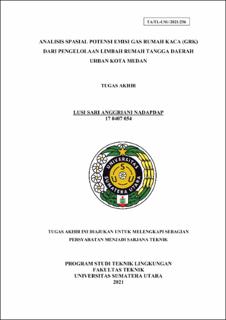| dc.description.abstract | Climate change is a global problem that needs to be solved with the cooperation of the countries in
the world. The existence of various human activities, especially since the pre-industrial era, caused
GHG emissions to the atmosphere to experience a very high increase, thereby increasing the
concentration of GHG in the atmosphere. This causes the problem of global warming and climate
change. One source of greenhouse gas emissions comes from the household waste sector. Waste in
this case is sourced from waste generation, open burning and waste water. The purpose of this study
is to calculate greenhouse gas emissions in the household-scale waste sector and to map the
distribution of GHG emissions (Greenhouse Gases) from household waste management in the urban
area of Medan City. In order to facilitate the determination of policies regarding GHG control,
the reading of the results of the emission inventory needs to be mapped. Mapping of GHG emission
loads using the Geospatial Information System, namely mapping using a base map by region with a
color scale so that it is easier to read using the QGIS version 3.16 application. The value of GHG
emissions is calculated using the IPPC tier 2 method. The calculation of GHG emissions from
household waste is carried out by calculating CH4 emissions from waste generation and waste water,
meanwhile CH4, N2O, CO2 emissions in open burning GHG emissions generated from household
waste are 3.215,97 tons CO2eq/year, GHG emissions from open burning are 1.005 tons CO2eq/year
and GHG emissions from household waste water management in urban areas of Medan City are
12.562 tons CO2eq/year, so that the total GHG emissions from household waste treatment of
16.783,57 tons CO2eq/year Mapping the distribution of GHG emissions from household waste
management (waste, open burning and waste water) in urban areas of Medan City classified from low,
medium and high. | en_US |


